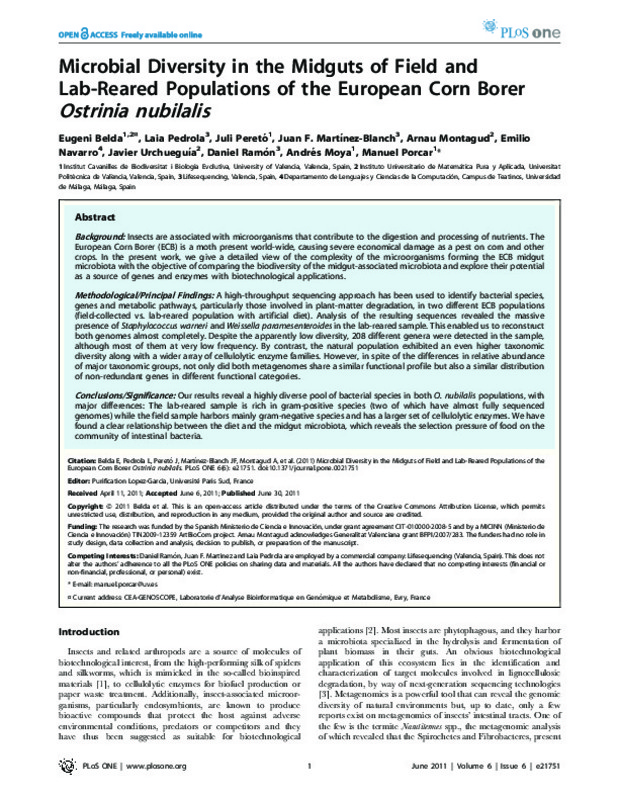Belda Cuesta, EA.; Pedrola, L.; Peretó Magraner, J.; Martinez Blanch, JF.; Montagud Aquino, A.; Navarro-Peris, E.; Urchueguía Schölzel, JF.... (2011). Microbial Diversity in the Midguts of Field and Lab-Reared Populations of the European Corn Borer Ostrinia nubilalis. PLoS ONE. 6(6):21751-21751. https://doi.org/10.1371/journal.pone.0021751
Por favor, use este identificador para citar o enlazar este ítem: http://hdl.handle.net/10251/28580
|
Título:
|
Microbial Diversity in the Midguts of Field and Lab-Reared Populations of the European Corn Borer Ostrinia nubilalis
|
|
Autor:
|
Belda Cuesta, Eugenio Antonio
Pedrola, Laia
Peretó Magraner, Juli
Martinez Blanch, Juan Francisco
Montagud Aquino, Arnau
Navarro-Peris, Emilio

 Urchueguía Schölzel, Javier Fermín
Ramon, Daniel
Moya, Andres
Porcar Miralles, Manuel
Urchueguía Schölzel, Javier Fermín
Ramon, Daniel
Moya, Andres
Porcar Miralles, Manuel
|
|
Entidad UPV:
|
Universitat Politècnica de València. Departamento de Termodinámica Aplicada - Departament de Termodinàmica Aplicada
Universitat Politècnica de València. Departamento de Física Aplicada - Departament de Física Aplicada
Universitat Politècnica de València. Instituto Universitario de Matemática Pura y Aplicada - Institut Universitari de Matemàtica Pura i Aplicada
|
|
Fecha difusión:
|
|
|
Resumen:
|
Background: Insects are associated with microorganisms that contribute to the digestion and processing of nutrients. The European Corn Borer (ECB) is a moth present world-wide, causing severe economical damage as a pest ...[+]
Background: Insects are associated with microorganisms that contribute to the digestion and processing of nutrients. The European Corn Borer (ECB) is a moth present world-wide, causing severe economical damage as a pest on corn and other crops. In the present work, we give a detailed view of the complexity of the microorganisms forming the ECB midgut microbiota with the objective of comparing the biodiversity of the midgut-associated microbiota and explore their potential as a source of genes and enzymes with biotechnological applications. Methodological/Principal Findings: A high-throughput sequencing approach has been used to identify bacterial species, genes and metabolic pathways, particularly those involved in plant-matter degradation, in two different ECB populations (field-collected vs. lab-reared population with artificial diet). Analysis of the resulting sequences revealed the massive presence of Staphylococcus warneri and Weissella paramesenteroides in the lab-reared sample. This enabled us to reconstruct both genomes almost completely. Despite the apparently low diversity, 208 different genera were detected in the sample, although most of them at very low frequency. By contrast, the natural population exhibited an even higher taxonomic diversity along with a wider array of cellulolytic enzyme families. However, in spite of the differences in relative abundance of major taxonomic groups, not only did both metagenomes share a similar functional profile but also a similar distribution of non-redundant genes in different functional categories. Conclusions/Significance: Our results reveal a highly diverse pool of bacterial species in both O. nubilalis populations, with major differences: The lab-reared sample is rich in gram-positive species (two of which have almost fully sequenced genomes) while the field sample harbors mainly gram-negative species and has a larger set of cellulolytic enzymes. We have found a clear relationship between the diet and the midgut microbiota, which reveals the selection pressure of food on the community of intestinal bacteria. © 2011 Belda et al.
[-]
|
|
Palabras clave:
|
Animal tissue
,
Article
,
Bacterial gene
,
Bacterial genome
,
Bacterium identification
,
Controlled study
,
European corn borer
,
Intestine flora
,
Metagenome
,
Microbial diversity
,
Microbial population dynamics
,
Midgut
,
Nonhuman
,
Population abundance
,
Staphylococcus
,
Staphylococcus warneri
,
Weissella
,
Weissella paramesenteroides
,
Bacteria (microorganisms)
,
Hexapoda
,
Lepidoptera
,
Negibacteria
,
Ostrinia nubilalis
,
Posibacteria
,
Zea mays
|
|
Derechos de uso:
|
Reconocimiento (by)
|
|
Fuente:
|
PLoS ONE. (issn:
1932-6203
)
|
|
DOI:
|
10.1371/journal.pone.0021751
|
|
Editorial:
|
Public Library of Science
|
|
Versión del editor:
|
http://dx.doi.org/10.1371/journal.pone.0021751
|
|
Código del Proyecto:
|
info:eu-repo/grantAgreement/MICINN//CIT-010000-2008-0005/ES/Desarrollo de nuevas tecnologías ómicas y su aplicación en la biosíntesis de etanol/
info:eu-repo/grantAgreement/MICINN//TIN2009-12359/ES/Integracion De Bases De Datos Biologicas Con Nuevas Herramientas De Computo En Biologia Sintetica Orientadas A La Produccion De Biocombustibles/
info:eu-repo/grantAgreement/Generalitat Valenciana//BFPI%2F2007%2F283/ES/BFPI%2F2007%2F283/
|
|
Agradecimientos:
|
The research was funded by the Spanish Ministerio de Ciencia e Innovacion, under grant agreement CIT-010000-2008-5 and by a MICINN (Ministerio de Ciencia e Innovacion) TIN2009-12359 ArtBioCom project. Arnau Montagud ...[+]
The research was funded by the Spanish Ministerio de Ciencia e Innovacion, under grant agreement CIT-010000-2008-5 and by a MICINN (Ministerio de Ciencia e Innovacion) TIN2009-12359 ArtBioCom project. Arnau Montagud acknowledges Generalitat Valenciana grant BFPI/2007/283. The funders had no role in study design, data collection and analysis, decision to publish, or preparation of the manuscript.
[-]
|
|
Tipo:
|
Artículo
|









